Increase the Revenues of Your Waste Company With the Tips Shared in Our Blog Articles

Why Every Waste Management Company Needs a Data-Driven Strategy: Transforming Raw Metrics into Real Revenue
Waste management has always been about logistics, grit, and grind. But, as industry demands shift, successful waste management companies must become data-driven powerhouses, not just trucks on the road. Without a strategy rooted in hard numbers and real-time metrics, you’re leaving yourself open to inefficiencies, profit leaks, and costly blind spots. The truth is, every ton you handle, every truck you run, and every service you price has hidden data points that, if harnessed, could lead directly to increased profits.
As the Waste Management Alchemist, I’ve seen countless companies overlook the one tool that has the power to transform their businesses from break-even operations to profit machines: data. And I’m not just talking about traditional metrics like revenue and expenses; I’m talking about using numbers to maximize efficiency, optimize pricing, and predict trends. Let’s dive into how a data-driven approach can shift the trajectory of your business, uncover hidden profits, and give you a clear, competitive edge.
[Join The Centurion Waste Alliance]
A New Kind of Power: Why Data-Driven Strategy is Non-Negotiable
Imagine a waste management company where every decision—whether it's the next route, processing choice, or disposal method—is informed by solid data. You know exactly what materials yield the highest return, which routes are most efficient, and where costs are getting out of hand. Data transforms guesswork into an actionable, profit-driven strategy. But here’s the reality: most companies are sitting on a goldmine of data they aren’t using.
What exactly does a data-driven strategy look like in waste management? It means implementing systems that track every aspect of operations—from collection routes to disposal costs, from processing time to tonnage breakdown by client. When analyzed, these metrics can tell you everything you need to know about which areas to boost, cut, or completely overhaul.
[Join The Centurion Waste Alliance]
Step 1: Using Data to Optimize Collection Routes
Let’s talk about one of the biggest cost centers in waste management—collection routes. Every day, trucks go out, pick up materials, and return for processing. Without data, you’re running those routes based on assumptions. Maybe you’re covering too much ground for too little material. Maybe some routes overlap unnecessarily. Or, worse, maybe high-value pickups are treated the same as low-value ones, draining your resources and profit potential.
With a data-driven approach, you can use metrics like fuel consumption per route, tonnage collected per trip, and vehicle wear and tear to identify your most and least profitable routes. Real-time data allows you to dynamically adjust routes for maximum efficiency. Say goodbye to wasted fuel, unnecessary stops, and underfilled trucks. This is the level of precision that turns a logistics-heavy business into a profit-centered operation.
Step 2: Maximizing Processing Efficiency with Real-Time Metrics
Once materials arrive at your facility, the clock starts ticking on costs. Labor, equipment usage, and processing time all contribute to the bottom line. Without knowing how long each material type takes to process, or what the true cost per ton is, you’re running blind. Real-time metrics on processing times and costs help you identify which materials are worth the effort and which are bleeding you dry.
For example, if metals take twice as long to process as plastics but bring in three times the revenue, you know where to allocate resources. Real-time tracking can reveal processing bottlenecks and flag inefficient workflows, which you can then streamline to cut costs and boost productivity.
Step 3: Setting Profitable, Data-Driven Pricing Strategies
This is a critical, often-overlooked area where data can make or break your business. Setting prices based on “what everyone else is charging” might keep you in business, but it won’t make you profitable. To set prices that cover your costs and secure a healthy margin, you need to know exactly what each service costs down to the cent.
A data-driven pricing strategy involves analyzing historical costs and current market conditions, allowing you to adjust prices by material type, route, or processing method. Some materials might justify premium pricing based on disposal costs, while others could warrant discounts due to lower handling expenses. You’ll be able to justify and explain your pricing to clients, providing transparency and, more importantly, protecting your margins.
[Join The Centurion Waste Alliance]
Step 4: Predicting Secondary Raw Material Market Trends
Selling secondary raw materials—like metals, plastics, and paper—is where waste management companies can see serious profit. But, these markets are notoriously volatile, and prices can swing based on everything from international demand to material quality. Tracking and analyzing data over time lets you predict these trends, putting you one step ahead of the market.
By following patterns, you can know when to hold onto materials and when to sell. If metals are forecasted to spike in the next quarter, you might adjust your processing priorities accordingly. Instead of blindly following market rates, you’re using real insights to time your sales and maximize profits. That’s what a data-driven strategy is all about—strategically positioning your business for the best possible return.
Step 5: Unlocking Hidden Profit with Comprehensive Data Analysis
A data-driven approach does more than optimize processes—it shines a spotlight on hidden profits and unnecessary expenses. By analyzing your numbers regularly, you’ll start seeing patterns you never noticed before. Maybe you’ll realize that a particular client contract costs more to service than it brings in, or that certain material types consistently yield higher profits.
Armed with these insights, you can make bold moves, like renegotiating client contracts, phasing out unprofitable streams, or expanding services to cater to high-margin materials. Waste management companies that embrace data have a significant advantage over their competition, one that is rooted in fact-based decision-making.
[Join The Centurion Waste Alliance]
Getting Started: Building a Data-Driven Strategy
You might be thinking, “This all sounds good, but where do I start?” Building a data-driven strategy doesn’t happen overnight, but the payoff is worth it. Here’s a practical roadmap:
Invest in the Right Technology: You can’t track data without the right tools. Invest in software designed for waste management that can track routes, costs, tonnage, and processing metrics.
Set Up Data Collection Points: Identify where data will come from. Collection trucks, processing facilities, and client interactions are all valuable sources of information. Establish consistent methods for gathering and recording data.
Start Small, Then Scale Up: Don’t try to analyze everything at once. Start by focusing on a single area—like route optimization or processing efficiency—and expand your strategy as you see results.
Analyze and Adjust Regularly: This isn’t a one-time project. Data-driven strategies work best with regular review. Set a schedule for analyzing your metrics and use these sessions to make ongoing improvements.
Use Data to Drive Every Decision: Finally, adopt a data-first mindset. Train your team to consult data before making major decisions, and embed this approach into every area of your operation.
[Join The Centurion Waste Alliance]
Transforming Your Business with Data: Why It Matters
If you’re serious about running a profitable waste management company, a data-driven strategy isn’t optional. The companies that thrive in this industry are those that move beyond gut instinct and run on numbers. They know where every dollar goes and comes from, and they have the agility to adapt based on real insights.
Waste management is a challenging industry, with tight margins and constant operational demands. But by putting data at the center of your strategy, you’re not just keeping your business afloat—you’re building a company that’s positioned to grow, adapt, and thrive.
Data is the difference between a waste management company that merely survives and one that becomes a profit-driven powerhouse. So take a hard look at your operations, find the gaps, and start implementing a strategy that turns raw numbers into real revenue.
Final Thoughts: Building the Future of Waste Management
Running a waste management company today demands more than trucks and processing equipment—it demands precision, insight, and a relentless focus on profitability. By embracing a data-driven approach, you’re not only optimizing your operations; you’re positioning your business as a leader in the field.
Let’s be clear: data isn’t just a tool for tweaking margins. It’s the bedrock of a thriving business strategy, one that unlocks profitability, predictability, and growth. So if you’re ready to take your waste management business to the next level, it’s time to put your numbers to work.
Because in this business, you’re either counting every dollar—or losing it.
To Your Success
Sam Barrili
The Waste Management Alchemist


© 2025 Marketing4waste - All Rights Reserved,
Marketing4Waste is a brand of MiM MarketingInterimManagers LLC
+1 801 804 5730

